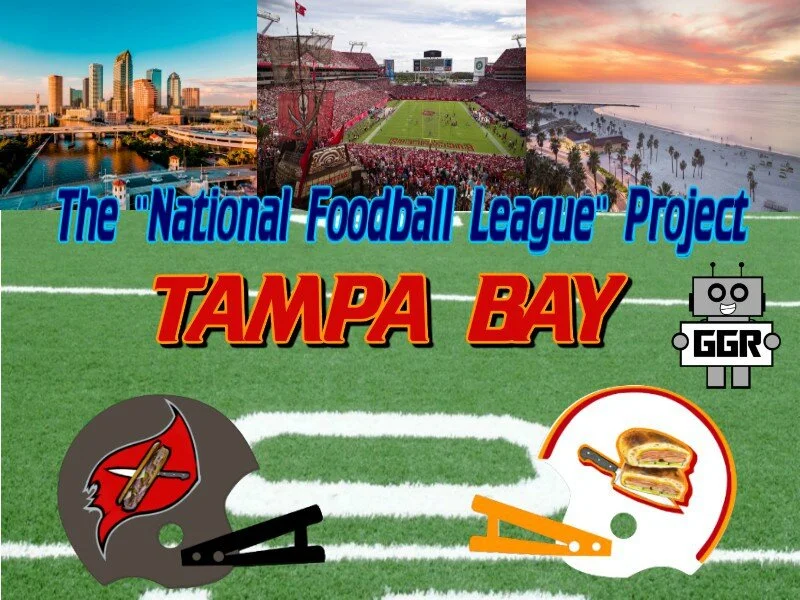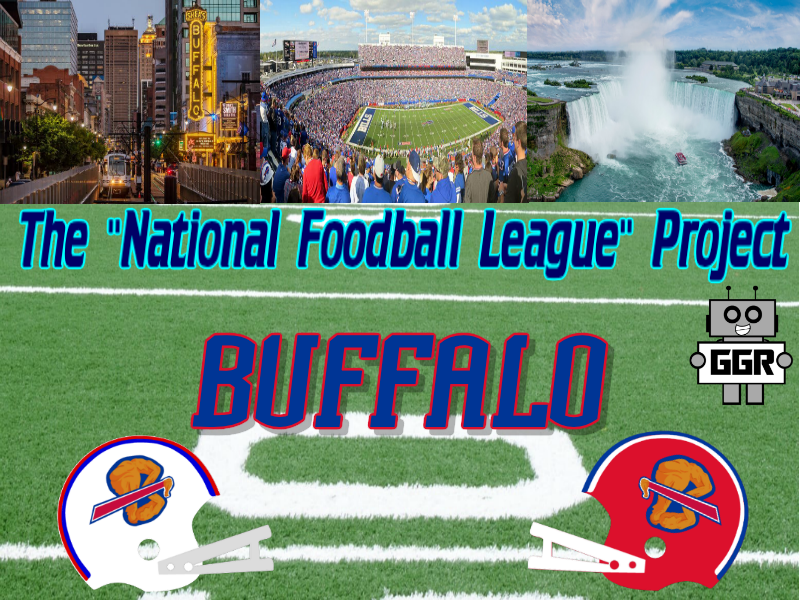"The National Foodball League" Project: New York City
by “Slice” Lunsford, Editor-In-Cheese for GGR
As we continue on this culinary journey, I’m starting in familiar territory. I’m hitting the East Coast cities that I spent a lot of time in growing up. Once we get into the midwest and western parts of the country…oh man, it will be a true adventure. But for now, we’ll keep it close to home as we venture further out in our culinary gridiron project.
A large part of my mom’s family settled in New York City after immigrating to the United States and that meant we got to visit the city, Long Island, and New Jersey frequently. When looking at sports: I can’t stand New York teams, mostly because their fans are so stuck up. There’s an air of superiority in everything they do and say. Makes me sick just thinking about it. However, I love New York City so much. I have so many good memories. My grandmother on my mom’s side is one of my heroes and she called Brooklyn home all the way up to the mid 40s after WWII. Her sister lived in Brooklyn for years afterwards and I still remember visiting their row house there. We used to go into Manhattan and see all the sights every few years. New York has a special place in my heart. So let’s talk about the Big Apple and it’s history with food.
New York City is a melting pot of racial and cultural influences. It has also been that way for quite some time, as it’s one of the oldest cities in the US. Like Philadelphia, NYC has been around since the beginning, another integral city in the fight for freedom from Britain. It developed an identity as a cosmopolitan center of high society and refinement but also a place where anyone who worked hard could make it.
New York City might be the most famous of American cities when it comes to the aspect of diversity. Every TV show, movie or other piece of media reminds us of this, beating us over the head with how diverse the city is, but mostly by having a cast of a show that is 99% white tell us.
Could that BE any more obnoxious?
But I digress. Plenty of media has been devoted to the way New York City has developed its reputation as a city with a very diverse population so let’s talk about the food.
When you think of New York City, what foods come to mind first? Hot dogs, pretzels, cheesecake, corned beef or pastrami sandwiches, but hold the phone. Let’s talk about the culinary history. Because of New York’s status as “the center of the universe,” that means a lot of immigrants came there to make a name for themselves. A metric ton of famous recipes and foods were created in the Big Apple.
Did you know spaghetti & meatballs was invented in New York City? Same thing with sausage & peppers. General Tso’s chicken? Same. Eggs benedict, chicken & waffles, black & white cookies, the concept of deliciousness, ask any New Yorker: that was created in their city. But there are two items that stand head and shoulders above all the other iconic foods: pizza and bagels. Are these foods New York natives? No, they came to the city via immigrants. But regardless of where they were born, they gained their fame and reputations in the city, which is why they represent New York so perfectly.
Tourists visiting the city will insist that they have to get authentic New York pizza. New York is pizza. Granted you will get many who want authentic New York bagels as well, but pizza is #1. And since there are 2 teams representing New York City, that means we get to cover pizza AND bagels and we don’t have to create some sort of monstrosity that Frankensteins the two things together in some sort of nightmare food.
I said what I said. Have some self respect and stop eating these abominations
Do you know why pizza is so uniquely associated with New York? Well, much like the joke “how do you know if someone is a vegan/crossfitter/atheist? Don’t worry, they’ll tell you in the first few minutes of meeting them,” New Yorkers will gladly tell you, almost reflexively, that you can’t get good pizza anywhere except New York. Pizza is OBVIOUSLY theirs, no one else is allowed to talk about much less make great pizza and even if it’s the best pizza they’ve ever had in say, Roanoke, Virginia, they would never admit it. The chef could be a 3rd generation pizzaiolo (proper term for a pizza maker. I looked it up!). He could have worked at Famous Ray’s in New York and a New Yorker would still say “ehhh, it was okay I guess. Not as good as home!” New Yorkers are like a jealous significant other when it comes to pizza.
Me: wow that looks great.
New Yorker: You lookin’ at my pizza?
Me: I was just noticing how delicious that looks.
New Yorker: Why don’t you get your own regional cuisine, pal?
Me: It’s not even yours! It’s from Italy! Every city in America has pizza.
New Yorker: Well, it ain’t good pizza! The only good pizza you can get…
Me: …is from New York, yeah. I know. I’ve heard that once or twice.
Without further insult to New Yorkers, Italians, Italian New Yorkers or pizzaiolos (I love that word now), let’s dive in to the history of the Italian tomato pie in America.
Pizza has been a part of the Italian diet since the 10th century. In fact, pizza is such a part of Italian culture and cuisine that the country created Associazione Verace Pizza Napoletana or the True Neapolitan Pizza Association in 1984. With a headquarters in Naples, its goal is to protect traditional Neapolitan pizza. I took this from wiki specifically so I can show you how important pizza is to Italians:
In 2009, upon Italy's request, Neapolitan pizza was registered with the European Union as a Traditional Speciality Guaranteed dish, and in 2017 the art of its making was included on UNESCO's list of intangible cultural heritage.
They literally created a Pizza Protection Agency and got the EU to give Neapolitan Pizza special protection like it’s an endangered species. So if you thought my joke was hyperbole…well…points at above paragaph.
With the 19th and early 20th century seeing a great deal of Italian immigrants coming to New York City and settling, it made sense that pizza would come, too. The dish gained a new life when these new, mostly poor Italian Americans needed something to eat. Enter Gennaro Lombardi, who was working at a grocery store and making pizzas that he would wrap up for his customers. A few years after coming to America, he opened the creatively named Lombardi’s Pizzeria in 1905. It is recognized by the Pizza Hall of Fame (I swear to God that’s a real thing) as the first pizzeria in America. Now…there’s some speculation that Lombardi’s is not, in fact the first pizza place but I’m not dumb enough to poke that bear, so we’ll stick with Lombardi’s is the first. No questions.
Look at that pizza. That screams perfection. The tomato sauce, the crispy crust, the slightly burnt cheese and a sprinkle of basil on top, all of them coming together to make this masterpiece. Hell, look at the table cloth! You know you can trust a pizza place that uses table cloths like that. I could probably eat the whole pie myself. Should I? No. Would I do it anyway and be stuffed afterwards? You betcha. This is Lombardi’s we’re talking about here. This is the first pizzeria! You don’t go into an institution like Lombardi’s and order a mixed green salad if you want to walk out of there with your knee caps intact. Am I insinuating that Lombardi’s would use mob tactics if I insulted the owners and that somehow they are associated with organized crime, AKA the Mafia? Of course not. There’s no such thing as the Mafia.
Bagels have a similar journey to America. Their roots begin in Jewish communities in Eastern Europe, most likely Poland as the first written mention of a bagel coming in 1610. It quickly became a staple of the Slavic diet and when people started coming to the United States in droves in the 19th and early 20th centuries, many of these Eastern European Jews brought their bagel recipes with them, in fact they quickly established a Bagel Baker’s Union that controlled who could and who couldn’t make bagels in New York City. The bread product became so popular that the concept of a “Bagel Brunch” was commonplace in the city. The bagel brunch consists of a bagel “schmeared” with cream cheese and topped with smoked salmon, tomato, red onion, and capers.
Bagels made a huge move to mainstream breakfast staple across the country in the 1960s. Inventor Daniel Thompson started work on the first commercially viable bagel machine in 1958 to help increase the yield bakers could produce. Bagel baker Harry Lender and his son Murray leased this technology and pioneered automated production and distribution of frozen bagels in the 1960s. Pretty much everyone has heard of or at least seen Lender’s Bagels, the biggest name in “find them in your local grocer’s freezer section” bagel but also, in a measure that saved millions of hands and fingers from injury, Murray Lender also invented pre-slicing the bagel. Countless Jews and the newly bagel-abundant Gentiles can thank him for his ingenuity and thoughtfulness because the slicing options are either dangerous or frightening looking.
“When you want a bagel sliced but also want a medieval torture device to vivisect your breakfast, choose the Bagel-defiler for all your slicing needs!”
So, without further ado let me introduce you to the New York representatives of the National Foodball League. We have the New York Pizza Pieants (God I love that pun) and the New York Bagels (not as clever but equally delicious). Now, the Jets have recently changed their color scheme slightly and updated their logo by going with the one they used in the 80s and 90s. After that they went back to the their original logo/color scheme from the 60s and 70s. But now it’s back to those 80s/90s colors because why put a lot of effort into a rebrand when you have a perfectly useable logo you tossed aside in the late 90s? Anywho, here’s the new/old/new logo and colors.
You can get a New York Pizza Pieants shirt via teespring! Click on the image below to get one today!
And BOTH versions of the New York Bagels!
We’re now 3 cities in and this adventure continues to be fun and super interesting. I learned a ton about New York City and it’s culinary marvels. Make sure you pick up a shirt, or a sticker or both! Links above and below!
I’ll continue to post my food history journeys as I share more of these “Foodball” mash ups. I hope you enjoy reading about and seeing my creations as much as I have enjoyed making them. More cities and food stories to come, so stay tuned!


























Mike returns to the “Foodball League Project” with an entry about the Steel City of Pittsburgh.